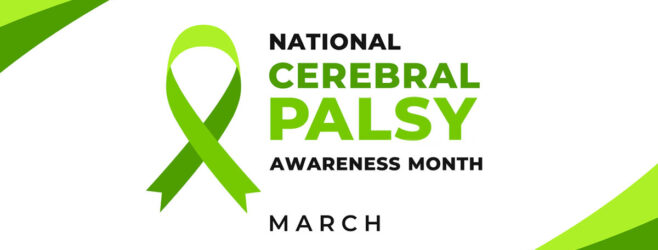March is National Cerebral Palsy Awareness Month. To mark this special occasion, the Birth Injury Justice Center is sharing ways people can help celebrate and spread awareness about cerebral palsy.
Learn how to get involved this month, whether by simply wearing the color green, calling for accessibility changes to support the cerebral palsy community, or helping loved ones access the support they need.
What Is National Cerebral Palsy Awareness Month?
National Cerebral Palsy Awareness Month is a month-long event celebrating people diagnosed with cerebral palsy and spreading awareness about the condition. During this time, those living with cerebral palsy are also encouraged to share their stories and support one another.
Cerebral palsy is a collection of neurological disorders affecting mobility and muscle tone. Sadly, this permanent condition is too often caused by preventable birth injuries like brain damage that can stem from negligence by doctors and other medical staff.
More than 1 million people are living with cerebral palsy in the United States, and 10,000 babies are diagnosed every year.
National Cerebral Palsy Awareness Month is a platform to educate the general public and encourage them to become allies for the cerebral palsy community. Allies are critical in advocating for inclusive spaces, continued research to find new treatment options, funding for wheelchair-accessible buildings, and more.
While the push for inclusive spaces is a year-round effort, National Cerebral Palsy Awareness Month is the perfect time to educate communities about this disability and the unique barriers people with cerebral palsy face every day.
Spreading Awareness About the Challenges of Cerebral Palsy
Cerebral palsy is a chronic condition, and there is no standardized treatment approach. This means that the disability can’t be cured, and people may need lifelong care to help them manage symptoms. As a result, many families face mounting expenses for ongoing treatment and financial strain when paying for adaptive equipment like wheelchairs and more.
Treatment for cerebral palsy may involve:
- Medication
- Physical therapy
- Speech therapy
- Surgery
These treatment options can greatly improve the quality of life for people with cerebral palsy. However, more research is needed to advance and improve these options for families. As a result, Congressman Steve Cohen of Tennesee introduced the Cerebral Palsy Research Authorization Act last year to secure $5 million in cerebral palsy research funding.
“The lack of dedicated federal funding has limited any potential advances into the care and treatment of cerebral palsy. There is no standard of care for treating cerebral palsy, and very few health care providers specialize in treating adults with cerebral palsy.”
– Congressman Steve Cohen
Because so few health care providers have the training needed to treat cerebral palsy, people may have to travel to get expert care, adding even more financial stress to families.
This stress can feel incredibly burdensome, especially for those whose disability was caused by a medical mistake during childbirth. Thankfully, families may be eligible to seek legal help after their child’s birth injury, allowing them to fight for the financial compensation they need to cover the cost of cerebral palsy treatment and care.
With registered nurses on staff, our team is ready to support you with your child’s birth injury. Contact us now to see how we can help.
How to Show Your Support During Cerebral Palsy Awareness Month
Despite the challenges of cerebral palsy, it’s important to remember that a disability never defines someone and that we can all work alongside the cerebral palsy community to expand inclusivity.
There are many things you can do to spread cerebral palsy awareness. One of the simplest ways to show your support for National Cerebral Palsy Month is to wear green. This color is associated with growth, vibrancy, and renewal of life.
Here are a few additional ways to show your support for the cerebral palsy community:
- Adjust how you speak about disabilities and avoid language like “handicapped,” which can be harmful to people with cerebral palsy
- Ask local schools to incorporate inclusive curriculum like “Just Say Hi” programming
- Donate to organizations such as the Cerebral Palsy Foundation to support the community
- Encourage people to learn more about the condition in honor of National Cerebral Palsy Awareness Day on March 25
- Help advocate for increased accessibility accommodations in public spaces so people with cerebral palsy have more freedom
- Join a cerebral palsy advocacy group to share your story and support others
- Listen to the stories of those who live with cerebral palsy
- Share photos and stories about cerebral palsy online
- Support businesses that are allies to the disability community
- Use #GoGreen4CP to raise awareness on social media
- Write a letter to lawmakers to advocate for federal funding for cerebral palsy research using the GoGreen4CP template
If you are interested in supporting the cerebral palsy community year-round, consider joining a cerebral palsy support group. There are plenty of online and in-person support groups around the country where you can share your story and be there for others.
Since its start in 2006, National Cerebral Palsy Awareness Month has fostered strength and unity among the cerebral palsy community and will continue to do so for years to come.
Legal Help for Birth Injuries
If your child was injured at birth due to medical malpractice, help may be available. Our registered nurses and legal advocates are ready to help you understand if your health care team failed to prevent injuries that resulted in cerebral palsy.
Cerebral palsy lawsuits can help families hold negligent medical providers responsible for the harm they caused and help pay for lifelong medical care.
Find out if your family might be eligible by contacting us at (800) 914-1562 right now or getting a free case review.



